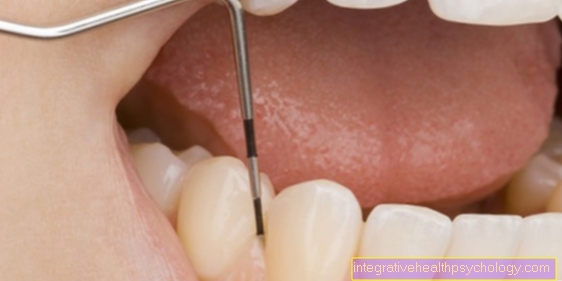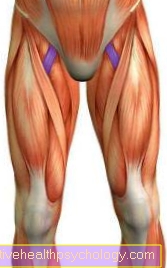Symptoms of Norovirus Infection
introduction
The norovirus is one of the most important diarrhea viruses. Although it can cause infections year-round, it is more common in the winter months from autumn to spring. The norovirus is known to cause endemics in public facilities, hospitals, and schools. This is due to the simple transmission routes, the high infection rate and infectiousness as well as the persistence of the pathogens, which make the virus difficult to control.
The norovirus causes inflammation of the gastrointestinal lining, especially in the small intestine. The inflammation can be very severe and extremely acute with the typical symptoms of severe gastrointestinal flu. The norovirus infection subsides just as quickly within a few days to a week.

The symptoms of the norovirus
The classic symptom combination of a norovirus infection is diarrhea and vomiting. Nausea can set in just a few hours after the initial infection with the pathogen. Then vomiting occurs, which is described as "gush-like". The diarrhea is followed by cramping abdominal pain. This can cause diarrhea that is so severe and fluid that the body can lose significant amounts of water. After the onset of vomiting diarrhea, there is also a strong feeling of illness. This feeling of illness is accompanied by fever, pain in the limbs and muscles. In addition, there are headaches, sensitivity to cold and the onset of tiredness and weakness.
As a result of the heavy loss of water, it is essential to ensure that the water and electrolyte balance is maintained. Excessive dehydration can lead to dizziness, weakness and fainting. Old and very young people are particularly affected.
In addition, pain in the limbs and bed rest caused by weakness can lead to back pain, rump pain and sore throat.
Learn more about this topic here Norovirus - How Dangerous Is It?
The symptoms of the norovirus at a glance
- nausea
- Vomit
- diarrhea
in addition:
- fever
- Body aches
- muscle pain
- a headache
- fatigue
- Cold sensitivity
Vomit
Vomiting is one of the most common and most unpleasant symptoms of an acute norovirus infection. It occurs as a result of nausea, which can set in a few hours after the infection. Vomiting usually subsides sooner than other symptoms. After just 1-2 days, nausea and vomiting can normalize so that food can be supplied again.
With strong, gushing vomiting, the risk of water, food and electrolyte losses is even higher than with diarrhea. Electrolytes are charged particles that play a major role in the regulation of metabolic processes. If there is a loss of the particles, the body becomes unbalanced and it can lead to weakness and dizziness.
In the case of severe or particularly protracted norovirus infections, a doctor may need to give intravenous fluids to prevent dehydration. Home remedies such as chamomile or ginger tea can also be used to combat vomiting. The hot liquid and the herbs have a gentle and calming effect on the gastric mucosa and can promote healing and relief.
Read more on the subject here: treat a norovirus infection
diarrhea
Diarrhea is another major symptom of norovirus infection. The diarrhea usually starts about a day after the original norovirus infection. Abdominal pain and cramps may occur beforehand, which heralds the onset of diarrhea.
The norovirus mainly affects the small intestine. The small intestine is also the area in the digestive tract where most of the fluid from daily food is absorbed and absorbed into the body. The virus attacks the mucous membrane of the small intestine and blocks these absorption mechanisms, resulting in massive excretion of water and food residues. At the same time, pathogens are excreted en masse with the liquid food residues. The body uses this diarrhea and vomiting to fight and get rid of the noroviruses. Even when the intestinal flora has recovered, there are still large amounts of noroviruses in the mucous membrane of the small intestine.
In the case of a norovirus infection, it is important to note that viruses are excreted in the stool for several days after the symptoms have subsided. Thorough toilet hygiene must be observed even a few days after the illness, as infectious pathogens are still present in the stool.
Headache and body aches
Typically with an increase in the fever, headaches and aching limbs also set in. The pain in the limbs is not uncommon with a rise in temperature and the onset of malaise. They are often an early symptom before the onset of fever and weakness.
The pain comes from the muscles, which is similar to the pain of sore muscles and is accompanied by a feeling of weakness. In order to raise the body temperature and increase the activity of the immune system, metabolic processes in the muscles are reduced. The body aches and pains help the body to come to rest, to keep bed rest and to give the body the necessary support in fighting the pathogens.
Headaches, on the other hand, can indicate the beginning of dehydration of the body. Often associated with a fever, they come on with a feeling of thirst. In particular, if the intake of food and water is reduced due to the general nausea, sharp headaches can occur when the temperature rises. A large glass of water and the necessary bed rest, as well as sleep, help in the first place.
more on the subject Body aches you can read here.
fever
Fever is an immune system response to norovirus infection. One speaks of a fever from a value of 37 ° C or higher. It is a general symptom that is very unspecific and only indicates that the body is taking action against inflammatory processes in the body.
In response to the norovirus infection, various messenger substances are released in the body, which lead to an increase in temperature. The body then tries to save and burn energy by restricting some body functions so that the temperature rises as quickly as possible. For this reason, at the beginning of the rise in fever, you may feel chills and cold as the body tries to conserve heat. When the fever falls, the body sweats accordingly to get rid of the heat.
The important benefit of fever is that immune cells can work better at the elevated temperature. A certain body temperature is therefore helpful in the acute phase of the disease and should not be lowered with medication. Only at temperatures above 40 ° C are too many bodily functions restricted, so that the fever should be reduced. Medicines from the group of NSAIDs, for example ibuprofen, indomethacin or diclofenac, are suitable for this.
More information on the subject fever you'll find here.
Muscle and joint pain
Muscle and joint pain are the typical early symptom of an impending flu. In general, influenza does not describe illness with an influenza virus, but the typical seasonal infection.
The muscle and joint pain are often the first signal of an impending illness. This is due to an activation of the immune system, which reduces metabolic processes in the muscles. As a result, muscles and joints feel exhausted and painful even without exertion.
The pain is often closely related to the development of the fever. When the fever rises, the pain increases. Fatigue and muscle pain are also less common in fever-free phases.
Other unspecific symptoms
Back pain
Back pain is not an immediate symptom caused by norovirus infection. When a fever develops, there is aching limbs and muscle pain. These are particularly often described as weakness and sore muscles-like pain in the lower back. No damage to the musculoskeletal system is to be assumed here.
Back pain can also arise from bed rest during the acute illness. This back pain is not uncommon with inactivity and bed rest for several days.
Sore throat
Sore throats include muscular discomfort as well as symptoms of the throat and throat, such as difficulty swallowing. The latter point to a flu-like course and rather speak against a sole norovirus infection.
Especially in the cold winter months, various pathogens can lead to cold symptoms with sore throat and throat, as well as runny nose, cough and hoarseness. If the gastrointestinal tract is affected, noro-typical symptoms such as vomiting diarrhea can follow. In seasonally favorable times, infections can also occur in combination, so that not only a norovirus infection has to be considered.
Find out more about the symptoms of the flu
stomach pain
Abdominal pain is a common symptom of inflammation of the gastrointestinal tract. The inflamed intestinal mucosa releases various messenger substances and is very sensitive to pain. Especially when stomach cramps and diarrhea follow as a protective mechanism of the body.
The stomach cramps not only affect the stomach, but the entire gastrointestinal tract. They represent the beginning of the diarrhea. To treat the stomach cramps, antispasmodic and analgesic medication can be taken. Apart from medication, many home remedies can relieve abdominal pain and cramps if they are tolerated in the illness.
Find out what against here Abdominal pain helps
Duration of symptoms
A conventional norovirus infection usually does not need treatment and only lasts for a few days.
After the first contact with the virus, it takes a few hours to a day for them to multiply in the body and settle in the intestines. There the pathogens attack the mucous membrane and cause malfunction of the intestine, causing diarrhea and vomiting. Vomiting usually lasts for about two days. The diarrhea can persist for an additional 3 days, so the total duration of symptoms is usually 4-5 days. Fever, body aches and headaches can also persist for about 4 days. They express that the body is still fighting against a high load of viruses. Even if the symptoms have subsided, a low risk of infection must still be expected. In any case, strict toilet hygiene must be observed for about two more days, as the pathogens are still excreted in the stool.
The entire duration is variable for each person. The strength of the immune system has a decisive influence on the fight against the pathogens. After taking immunosuppressive medication, as part of an immune-weakening disease, in old age or in small children, a weakened immune system can be expected.
The time between infection and the onset of symptoms is shortened, but the entire duration of the illness can be significantly lengthened. It is not uncommon for all those affected that even after the last symptoms have disappeared, a certain amount of tiredness and weakness remain when the body recovers from the past stresses of the disease.
Find out more at: Duration of norovirus disease
Can you have a norovirus infection without diarrhea and vomiting?
Norovirus infection can occur without the typical symptoms. This mainly depends on the aggressiveness of the pathogen and the immune system of the person concerned.
Many infections go completely unnoticed or only with a low fever for a day. Vomiting, in particular, does not have to occur with every norovirus infection. Diarrhea is more common, but many people can compensate for it well and be weak or not at all.
These symptoms can help you identify norovirus infections in babies and young children
In babies and young children, the virus and the body's response behave differently than in adults. Vomiting and diarrhea don't always have to occur.
In children, an incipient infection is often noticeable on the basis of behavior. If the child shows disinterest and is more weepy than usual, this may indicate a general feeling of illness. When it comes to the norovirus, babies are particularly weak in drinking. Diarrhea and vomiting are clear warning signs that the child has had norovirus infection.
This is more likely to happen between October and March in particular.
In contrast to adults, a child must be presented to a doctor if they have watery diarrhea, as they can become dehydrated with circulatory collapse much more quickly. Particularly with babies and small children, special hygiene must be observed, as the pathogens from the stool can even spread over certain distances through the air.
Read more about this under dehydration- How can you tell?























.jpg)





